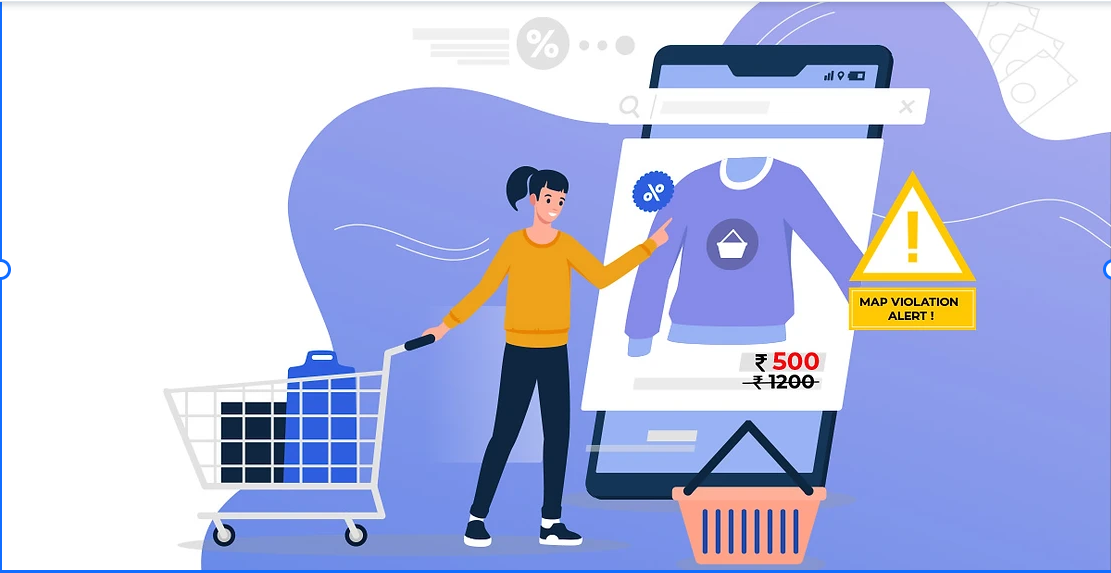Identification of MAP (Minimum Advertised Price) violators in real-time is critical for brands as it could damage brand reputation and product worth beyond repair in a quick time.
The path to success on eCommerce marketplaces depends upon your choice of sellers and their performance. Monitoring Seller performance gives brands a much-needed edge in the competitive digital commerce landscape. The brands selling through re-sellers need to be well aware of their performance as it directly reflects upon a brand image.
Let delve deeper to understand why brands need to build their strategies with insights on sellers’ performance, need to track MAP violations, and how it affects brand reputation and product worth on eCommerce marketplaces.
Are you aware of at what price your product is sold?
Consider a scenario – India top water purifier manufacturing company is selling its RO via authorized seller X at ₹16,400 while another seller Y is selling it at ₹12,900 while the brand has set the Threshold price of ₹14,500. The offer is enticing for shoppers but how will it impact your brand?
- Prompt other sellers to lower the price
- Leads to a domino effect on pricing and ultimately reduces the actual worth of the product
- Lose the trust of shoppers due to such price variation across sellers on a marketplace
- It affects your distribution channel
To combat such a scenario brand, need to track pricing across pin codes and platforms with seller-level analysis. These scenarios are known as MAP (Minimum Advertised Price) Violations or Pricing Violations.
A Similar scenario takes place when a seller offers more discount than the brand’s threshold discount known as Discount Violations. Identification of MAP violators in real-time is critical for a brand as it could damage brand reputation and product worth beyond repair in quick time.
Save Your Brands from the Domino Effect of MAP Violations
The “Domino effect of MAP (Minimum Advertised Price) Violations” refers to the potential negative consequences that can occur for a brand if MAP violations are not effectively managed and controlled.
When one seller violates the MAP policy by advertising a product below the set minimum price, it can trigger a chain reaction of other sellers following suit, leading to a price war. This can ultimately lead to price erosion, degrade brand value, product worth and reduce profit margins.
To prevent the domino effect of MAP violations and protect their brand, companies can take several proactive measures:
-
Product Pricing Tracking:
Brands should continuously monitor product prices across various eCommerce marketplaces and geographical regions. By doing so, they can identify sellers who are not adhering to the MAP policy and take appropriate action.
-
Awareness of Violations:
Brands need to stay vigilant and promptly identify any MAP violations. Timely awareness allows them to address the issue before it escalates and impacts their brand reputation.
-
Strengthening MAP Policies:
Companies should regularly review and update their MAP policies to ensure they are clear, comprehensive, and enforceable. By setting strict guidelines and penalties for violations, brands can deter sellers from engaging in price-cutting strategies.
-
Enforcement:
Once a MAP violation is detected, it’s essential for the brand to take swift and decisive action against the non-compliant sellers. This could involve warnings, temporary suspensions, or even terminating partnerships with repeat offenders. By enforcing the policy consistently, the brand demonstrates its commitment to maintaining fair pricing and protecting its image.
-
Identifying Sellers with High and Low ASPs:
Apart from focusing solely on MAP violations, brands should also analyse and categorize sellers based on their Average Selling Prices (ASPs). Sellers with significantly high ASPs may indicate potential unauthorized resellers, while those with extremely low ASPs might be engaging in MAP violations. Identifying and addressing such sellers helps in better controlling pricing and brand representation in the market.
-
Establishing Authorized Reseller Programs:
Implementing an authorized reseller program can help brands maintain better control over the distribution of their products. By designating specific authorized sellers, brands can ensure that their products are sold through reliable and trustworthy channels, reducing the likelihood of MAP violations.
-
Monitoring and Reporting Tools:
Brands can leverage technology and automated tools to monitor online marketplaces, flag potential MAP violations, and generate detailed reports on seller pricing trends. This data-driven approach can provide valuable insights for decision-making and identifying patterns of non-compliance.
By taking a proactive and comprehensive approach to MAP policy management, brands can mitigate the risk of the domino effect of MAP violations. This not only protects their brand equity and pricing integrity but also fosters stronger relationships with authorized sellers and customers.
Why do brands need to monitor seller performance on e-commerce marketplaces?
Brands need to monitor sellers’ performance on eCommerce marketplaces for several important reasons:
-
Brand Reputation Management:
The performance of sellers directly impacts the perception of the brand. If customers have a negative experience with a seller, they are likely to associate that negative experience with the brand itself. Monitoring seller performance allows brands to maintain their reputation and ensure that customers have a positive buying experience.
-
Quality Control:
Brands often have specific standards and quality requirements for their products. Monitoring seller performance helps ensure that these standards are met consistently, maintaining product quality and customer satisfaction.
-
Customer Experience:
Brands want to provide a seamless and positive customer experience across all channels. By monitoring sellers, they can identify and address any issues that might arise, regarding delivery time, customer experience, or product information.
-
Competitive Advantage:
Brands usually have multiple sellers selling their products on various eCommerce platforms. By monitoring seller performance, brands can identify high-performing sellers and collaborate more closely with them to gain a competitive advantage.
-
Sales Performance:
Monitoring sellers allows brands to track the sales performance of their products and identify trends and opportunities for growth. This data can be used to make informed decisions regarding inventory management, marketing strategies, and expanding product reach.
-
Monitoring the Seller Buy Box Win %:
Brands must monitor the Seller Buy Box Win % to ensure marketplace dominance and maintain control over product visibility. This metric reflects which sellers consistently win the Buy Box, impacting sales and brand perception. By tracking it, brands can strategize to optimize their presence and maximize revenue opportunities.
-
Pricing and MAP Compliance:
Brands often have minimum advertised price (MAP) policies to maintain consistent pricing across all channels. Monitoring sellers helps identify any violations of MAP policies and enables the brand to take appropriate action to protect its pricing integrity.
What are the Key Performance Indicators (KPIs) a brand need to track Sellers on?
- Customer Reviews and Ratings: Insights into customer satisfaction and can help identify sellers with consistently positive or negative feedback.
- Product Listing Accuracy: Accurate product information, including product titles, descriptions, images, and specifications.
- Inventory Levels & Availability: Avoid out-of-stock situations and ensures that sellers can fulfil customer orders promptly.
- Compliance with Policies: Monitor sellers’ adherence to their policies, such as MAP compliance and intellectual property rights protection.
- Order Fulfilment Time: These measures how quickly sellers ship orders after receiving them. Faster order fulfilment improves the customer experience and reduces the likelihood of cancellations.
- Order Defect Rate (ODR): ODR tracks the percentage of orders with defects, such as late shipments, damaged products, or order cancellations. A high ODR indicates poor seller performance.
- Return Rate: The percentage of products returned by customers can indicate potential issues with product quality or inaccurate product descriptions.
- Sales Performance Metrics: Tracking the number of sales, revenue generated, and conversion rates for products sold by each seller.
By analysing these KPIs, brands can identify high-performing sellers, address underperforming ones, and ultimately enhance their brand presence and customer experience on eCommerce platforms.
Final Thoughts
The Competitive eCommerce Landscape requires brands to be on their toes in every aspect of optimizing product performance on eCommerce platforms. The strong distribution network of the brand across channels plays a key role in making the brand successful. MAP violations are a threat to brand reputation, identifying them on time and taking prompt action can save your brand. Tracking sellers and product performance across platforms & geographies can help brands identify gaps in their strategies and take prompt action. A comprehensive digital commerce intelligence is what every brand needs. Business intelligence that can provide insights into competition product performance, and the brand’s own product performance.
Prepare your brand for evolving eCommerce landscape and its challenges, do not fall behind.





